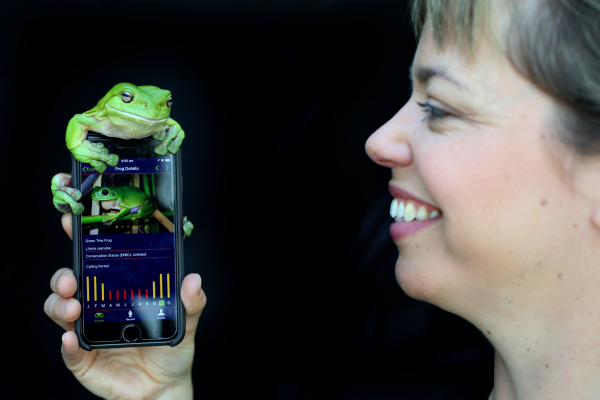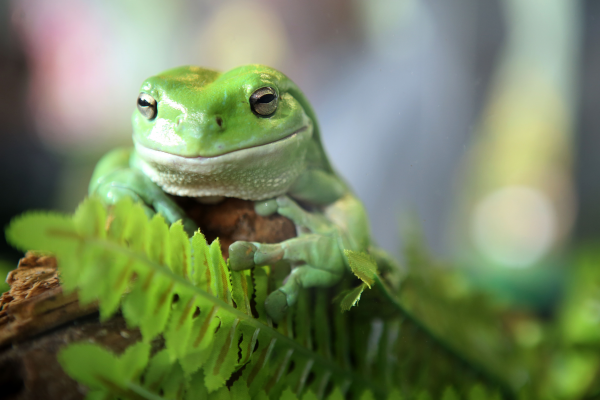






Project Overview
Australia has over 240 known species of frog, almost all of which are found nowhere else in the world. Some species are flourishing, like the Striped Marsh Frog. But others have declined dramatically since the 1980s, and four have become extinct. FrogID is a national citizen science project that is helping us learn more about what is happening to Australia’s frogs. All around the country, people are recording frog calls with nothing more than a smartphone. With the data obtained through FrogID we are able to track the Cane Toad and identify where frogs are thriving and where they aren’t. And by matching calls to weather and habitat, we are learning more about how different frog species are responding to a changing environment. This information could be crucial in saving Australia’s frogs and vital for ensuring a sustainable future for Australia.
Project Commissioner
Project Creator
Team
In November 2017, IBM iX was engaged by the Australian Museum to design, develop and launch a unique Citizen Science Program. FrogID is a five-year, nationwide research initiative that employs crowd-sourcing concepts to count and map the frogs of Australia. As scientists rely more on frog calls than appearance for accurate identification, the solution encourages users to make audio recordings of frogs’ unique croaks, chirps, and whistles and upload these to an online database. This is followed by an expert verification process which notifies users about the frog recorded. Through the combination of this with GPS data, the app augments museum research about the size, location and health of frog populations, articulation of species at risk, and insights on the state of creeks, rivers, lakes and wetlands. This helps safeguard frogs and their habitats and can even identify new species.This showcases IBM iX’s user centric approach to building solutions designed for ease of use and scale. Partnering with the museum the team continues to apply agile methods ensuring continuation of iterations and enhancements as further feedback is received. Dr Jodi Rowley, the Australian Museums herpetologist says "FrogID has done so much in such a little time to help advance our understanding of Australia’s unique and often threatened frogs - gaining an understanding of where frog species are and how they’re doing. I couldn’t have achieved even a tiny fraction of what FrogID has achieved in a dozen lifetimes!" Since the launch FrogID has successfully collected over 106,000 verified frog calls spanning across 187/240 known frog species. In 18 months FrogID has generated 20% of the total frog records ever collected in Australia, a new record for this area of science. While some species are recorded often, such as the Peron’s Tree Frog, others are not. In October 2018, the museum received its first submission of Mahony’s Toadlet, an endangered species that scientists only discovered in 2016. For the museum, every record of rarely-encountered species provides critical insight into how frogs are responding to a changing environment. The team was awarded the 2019 Eureka prize for Innovation in Citizen Science, the country’s most comprehensive national science awards, honouring excellence across research & innovation, leadership, science engagement, and school science. The Hon Karen Andrews, Australia's minister for Industry, Science and Technology stated that: “In less than two years, FrogID, winner of the Eureka Prize for Innovation in Citizen Science, has touched all corners of Australia, revealing insights into Australia’s frog distributions, breeding seasons and habitats. The team should be incredibly proud of their work. This project is a brilliant concept, and getting involved is as simple as downloading the app to submit recordings of frogs as you hear them. It really shows what can be done with a bit of innovative thinking.” In 2018 FrogID was also awarded a Green Globe Award in the Natural Environment category from the State of New South Wales (NSW) and Office of Environment and Heritage.
Project Brief
The Australian Museum’s mission is to inspire exploration, understanding and care for the world. In 2017, the Australian Museum (AM) celebrated 190 years, marking its significant role as the nation’s first museum. Since establishment in 1827, the AM has been at the forefront of scientific research, collection and education in the region. FrogID is the Australian Museum Centre for Citizen Science flagship campaign focusing on one of the most charismatic and threatened animal groups – frogs. Of our 240 known frog species, four have already disappeared and more face extinction. When it comes to frog conservation, one of the biggest obstacles is scientists’ lack of knowledge about these shy amphibians. FrogID has been developed as Australia’s first national frog count, a scientific rescue mission that everyone can be involved in. The Australian Museum objectives for the project were: To put Australia’s frogs on the map, by encouraging people to participate in the Australian Museum Citizen Science Program FrogID, via the FrogID app and related website, social media and community events; A call to action to encourage people of all ages and backgrounds to track, record and help identify frog species across the country by submitting audio recordings of frog calls via the FrogID app, developed in partnership with IBM iX Sydney; To document and conserve frog species and their habitats by creating the first frog census by using innovations in mobile data collection and citizen science for scientific research.
Project Need
Frogs are among the first animals to respond to environmental changes, like pollution, climate change or habitat change. For this reason, frogs are often referred to as the “canary in the coal mine” and their disappearance is an early warning that something is wrong with the environment. They also have a cocktail of chemical compounds on their skin, which are being explored for use in human medicine. Alarmingly, they are one of the most threatened groups of animals on the planet! Our biggest challenge is that we don’t know enough about them, yet. Australia has a landmass almost equivalent to the size of the US. More than 86% is classified as remote or very remote. Amidst these arid areas, frog species may only be detectable by their calls after a rainfall. Making these timely visits is near to impossible. Encouraging citizens to photograph frogs can make identifying species inaccurate, and may also inadvertently encourage handling of frogs and damage to the ecosystem.
User Experience
FrogID is pioneering sound classification by harnessing the power of people and their mobile phones. FrogID is a unique citizen scientist initiative that has hopped in to help Australia crucially understand the health, existence and decline of our frog populations. Insights and key trends in declines and hotspots in frog species from the data collected ensure that the right conservation and urbanisation decisions are made before it's too late. Utilising Design Thinking and motivation theories during the initial design, we were able to depict a clear understanding of the needs, pain points and behaviours of our users, both human and frog. From our design research we were able to envision a sustainable future, and craft a unique solution that transformed what could be seen as a mundane task, to a more adventurous journey of discovery, both educational and rewarding. All while maintaining the precautionary balance of not damaging the ecosystem further. For example, to minimise the effects and disruption of radiant lighting from the mobiles on nocturnal animals, the team has added darker colours to the app. Continuously striving to improve our user experience, we would like to increase the motivation techniques provided to the user to encourage them to continually participate in the program. Introducing milestone badges for the collection of recordings. Work closer with the most regional sites in Australia to fill the gaps in the data and experiment with artificial intelligence and 5G to provide real-time recording validation reducing the wait time for verification.
Project Marketing
Social media is a powerful tool for reaching audiences all over Australia. We’ve built a build a broad supporter-base network of citizen scientists all over Australia to help establish the FrogID research. With the app reaching over 1 million impressions within the first month of launch, FrogID is Australia’s first national citizen scientist frog research project – developed to help protect threatened species of frogs across the country. This is the first time major museums from each State and Territory across Australia have worked in partnership on a national citizen science research project. The FrogID app and related website, social media and community events, has enabled people of all ages and backgrounds to track, record and help identify frog species across the country, by submitting audio recordings of frog calls - matching frog calls with weather data and GPS location. Since the launch of FrogID in November 2017, we’ve built a citizen supporter database with various levels of engagement and multiple access points to get further involved – from joining us on social media, downloading the FrogID app, utilising the website, forming an online group or hosting a local event at school or in the community. The FrogID project has used social media, videos, hashtags and user-created content to reach new audiences and engage supporters into becoming citizen scientists, event registrations and even donors.
Project Privacy
FrogID requests users create accounts before submitting recordings, which include personal identification tokens, names and email address. Submitted frog recordings capture location data including latitude, longitude, time-of-day and timezone. This information is stored securely and shared only with permitted third-parties for the purposes of ecologic research. Data set's such as location and time-of-day are critical information for the ecological data analysis at the heart of the FrogID application. All submitted recordings' copyrights are held by the user, thus their names & contact details are stored for these purposes. User information can be shared with FrogID Related Parties for necessary IT services or for customised content/advertising in accordance with relevant Privacy law. Website interactions use cookies to track site interactions for the purposes of interaction analytics & improving the platform. Users can request to view/delete their personal information at any time. Deleting user data purges all identifiable information from Australian Museum's systems and thus can no longer be shared with any authorised third-parties. The Australian Museum holds then holds the newly anonymised recording submission data for further research purposes, with all personally identifiable information removed.
Digital - EdTech
EdTech focuses on how education is changing through technology, changing the way we learn and process knowledge. What will stand out here is those that enhance the learning experience and make a lasting impression.
More Details

